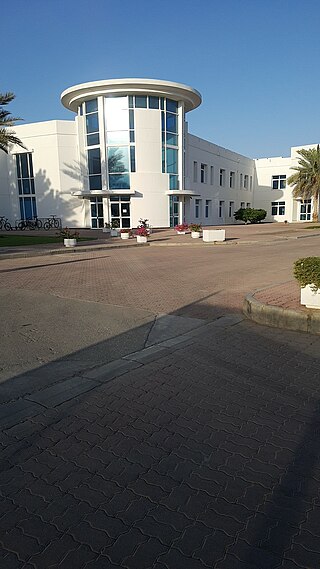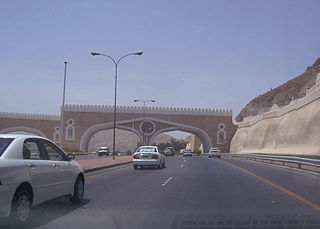Related Research Articles

Muscat is the capital and most populated city in Oman. It is the seat of the Governorate of Muscat. According to the National Centre for Statistics and Information (NCSI), the total population of Muscat Governorate was 1.4 million as of September 2018. The metropolitan area spans approximately 3,500 km2 (1,400 sq mi) and includes six provinces called wilayats. Known since the early 1st century AD as an important trading port between the west and the east, Muscat was ruled by various indigenous tribes as well as foreign powers such as the Persians, the Portuguese Empire and the Ottoman Empire at various points in its history. A regional military power in the 18th century, Muscat's influence extended as far as East Africa and Zanzibar. As an important port-town in the Gulf of Oman, Muscat attracted foreign tradesmen and settlers such as the Persians, Balochis and Sindhis. Since the ascension of Qaboos bin Said as Sultan of Oman in 1970, Muscat has experienced rapid infrastructural development that has led to the growth of a vibrant economy and a multi-ethnic society. Muscat is termed as a Beta - Global City by the Globalization and World Cities Research Network.

Muttrah, administratively a wilayah (province), is located in the Muscat Governorate of Oman. Before the discovery of oil in Oman, Muttrah was the center of commerce in Oman (Muscat). It is still a center of commerce as one of the largest sea ports of the region is located there. Other landmarks include Souq Muttrah, a traditional bazaar and Sour Al-Lawatiah, a small community of houses surrounded by an old wall. To the south lies Muscat District.

Ruwi is a commercial hub and the main business area of Muscat, the capital of Oman. Attractions in Ruwi include a variety of multi-confessional religious buildings, a National Museum, a clock tower, and a park. The population of Ruwi is 85,601.

The Sultanate of Muscat and Oman, also known briefly as the State of Muscat and Oman during the rule of Taimur bin Feisal, was a sovereign state that encompassed the present-day Sultanate of Oman and parts of present-day United Arab Emirates and Pakistan, in the second half of the 19th century and 20th century. Ruled by the Busaid dynasty, it was established as a result of the partition of the Omani Empire upon the death of its last ruler Said bin Sultan. The Sultanate transitioned into a new form of government after the palace coup of 23 July 1970 in which the sultan Said bin Taimur was immediately deposed in favor of his son Qaboos bin Said.

Al-Seeb, As Seeb or As Sib is a coastal fishing city, located several kilometres northwest of Muscat, in northeastern Oman. As of the 2020 census, it had a population of 470,878.

The Al Alam Palace is a palace located in Old Muscat, Oman. It was used as a ceremonial palace by Sultan Qaboos bin Said Al Said.

Oman is a country on the Arabian Peninsula. Tourism in Oman grew considerably during the 2000s, and a 2013 report predicted that it would become one of the largest industries in the nation. In 2019, Oman attracted about 4.1 million visitors from around the world, a massive increase from 3.1 million in 2017 as per the 2019 Tourism Statistic Bulletin from the National Centre for Statistics and Information (NCSI), Oman.

This page list topics related to Oman.

Bait Al Zubair is a museum, located on Al Saidiya Street, Old Muscat, Oman.
The Omani French Museum is a heritage museum located in the former residence of the French Consul, Bait Faransa on Lane 9310, Qasr Al Alam Street, in Old Muscat, Oman.

The Muscat Gate Museum is a museum located on Al Saidiya Street, Old Muscat, Oman.

Al Jalali Fort, or Ash Sharqiya Fort, is a fort in the harbor of Old Muscat, Oman. The fort was built by the Portuguese under Philip I of Portugal in the 1580s on an earlier Omani fortress to protect the harbor after Muscat had twice been sacked by Ottoman forces. It fell to Omani forces in 1650. During the civil wars between 1718 and 1747, the fort was twice captured by Persians who had been invited to assist one of the rival Imams. The fort was extensively rebuilt later.

The Royal Oman Police (ROP), also known as Oman Police, is the main law and order agency for the Sultanate of Oman. It maintains a helicopter fleet and also carries on the duties of safeguarding the long Omani coastline.
Soumyen Bandyopadhyay is an architect and architectural historian at Liverpool University where he is head of department and holds the Sir James Stirling Chair in Architecture. He has previously held professorial positions at the Manchester School of Architecture (MSA) and Nottingham Trent University.

Muscat International Airport, formerly Seeb International Airport, is the main international airport in Oman and is located in Seeb, 32 km from the old city and capital Muscat within the Muscat metropolitan area. The airport serves as the hub for flag carrier Oman Air and Oman's first budget airline Salam Air, and features flights to several regional destinations as well as some intercontinental services to Asia, Africa and Europe.

The American International School Muscat (TAISM) is an American curriculum international school in Muscat, Oman, serving early childhood through high school. Established in 1998, it is the sole American-only curriculum school in Oman.

Sultan Qaboos Street is a major highway in Muscat, the capital of Oman. It is named after Sultan Qaboos.

Old Muscat is the original historic city of Muscat, the capital of Oman, on the coast in the Gulf of Oman.

The Royal Office transliterated:maktab al sultani is one of the most senior and therefore powerful ministries in the Sultanate of Oman. It is a government body that has most influence in national security and intelligence issues and the minister in charge has been the de facto national security advisor to the Sultan. The Palace Office also acts as a foreign liaison focus on all international intelligence and security matters.

Mohammed bin Said bin Salim Al Shanfari was an Omani dramatist playwright and director. It was said of him that “His ideas inspired a generation.” He spent his working life advancing the cause of drama and the theatre. He received several awards in recognition of his work together with favourable reviews in Arabian media while he was alive, and also after his death.
References
- ↑ "Al Saidiya Street". PlacesMap.net. Retrieved 21 May 2017.